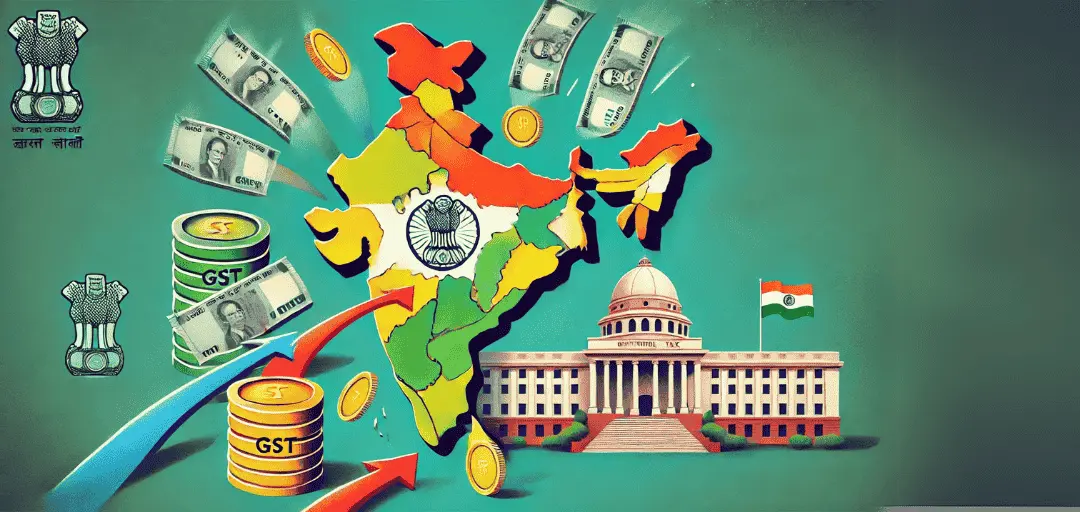How Different States in India Benefit (or Lose) Under GST Revenue Distribution
The introduction of the Goods and Services Tax (GST) in India was a landmark reform aimed at streamlining the country’s complex tax structure. While GST has simplified indirect taxation, its revenue distribution among states has led to varied financial impacts. Some states have gained significantly, while others have faced revenue shortfalls. This blog explores how different states in India benefit or lose under GST revenue distribution and how income tax deductions play a role in the overall financial ecosystem.
Understanding GST Revenue Distribution
GST is a destination-based tax, meaning the state where goods or services are consumed receives the tax revenue, rather than the state where they are produced. This has been a major shift from the previous tax regime, where producing states had more control over tax collection. To compensate states for potential revenue losses, the government introduced the GST Compensation Cess. However, disparities still exist in revenue distribution.
States That Benefit Under GST
Some states have experienced significant gains under the GST regime due to their status as consumer-heavy regions. These include:
- Maharashtra – As India’s financial capital, Maharashtra benefits from high consumer spending and service sector taxation.
- Uttar Pradesh – With a large population and increasing urbanization, UP enjoys a boost in GST revenue.
- Karnataka – The state’s thriving IT and service industry contributes significantly to GST collections.
- West Bengal – High consumption patterns and growing industrialization help West Bengal secure strong GST revenue.
For these states, GST has helped stabilize finances, reducing reliance on other revenue sources such as income tax deductions and state excise duties.
States That Lose Revenue Under GST
On the flip side, certain states that were previously major producers now find themselves at a disadvantage. These include:
- Gujarat – As a manufacturing hub, Gujarat has seen a decline in revenue since GST is collected at the point of consumption.
- Tamil Nadu – Home to a massive industrial base, Tamil Nadu faces revenue loss due to the shift from an origin-based tax system.
- Haryana – A key player in automobile and industrial production, Haryana’s revenue growth has slowed under GST.
- Punjab – Historically reliant on VAT collections from industries, Punjab has suffered losses due to the GST framework.
To counteract these losses, these states rely on alternative revenue streams, including income tax deductions, property taxes, and local levies.
The Role of GST Compensation and Its Challenges
To address revenue disparities, the central government introduced the GST Compensation Cess, which ensures states receive at least 14% annual revenue growth for a transition period of five years. However, several challenges persist:
- Delays in Compensation Payments – Many states have raised concerns about delayed compensation, affecting their financial planning.
- End of Compensation Period – With the transition period ending, states must find new ways to generate revenue.
- Impact of Economic Slowdowns – Economic downturns reduce GST collections, exacerbating financial stress for some states.
Income Tax Deductions and Their Influence on State Finances
While GST primarily deals with indirect taxes, income tax deductions play a crucial role in state economies. Here’s how:
- Encouraging Investment and Spending – Higher disposable income due to tax deductions leads to increased consumer spending, indirectly boosting GST collections.
- Supporting Business Growth – Tax benefits for businesses help them reinvest profits, leading to economic expansion and higher tax revenues.
- Reducing Financial Burdens on Individuals – By lowering taxable income, deductions increase purchasing power, benefiting states with high consumption.
- Strengthening State Revenues – More taxpayers utilizing income tax deductions means an increase in local economic activity, positively affecting GST revenue collection.
- Enhancing Public Services – Revenue collected from GST and taxes, including income tax deductions, is used to fund public infrastructure and services.
Thus, while GST impacts state revenues directly, income tax deductions create a ripple effect, influencing overall economic activity.
Strategies for States to Adapt to GST Revenue Distribution
With GST reshaping state finances, governments must explore new strategies to maintain economic stability. Some effective measures include:
- Expanding Local Tax Bases – States can enhance property tax collections and introduce innovative levies.
- Boosting Investment in Key Sectors – Encouraging industries that thrive under GST, such as e-commerce and logistics, can drive revenue growth.
- Strengthening Digital Tax Administration – Enhancing tax compliance through digital monitoring can reduce revenue leakages.
- Leveraging Income Tax Deductions to Attract Talent – Offering tax incentives to professionals and businesses can boost state economies.
- Encouraging Entrepreneurship – Reducing tax burdens and utilizing income tax deductions to support startups can create long-term revenue benefits for states.
Conclusion
The GST revenue distribution model has created winners and losers among Indian states, reshaping their financial landscapes. While consumer-heavy states benefit, industrial states face challenges. As the GST compensation period ends, states must innovate to secure sustainable revenue sources. Moreover, income tax deductions continue to play a crucial role in economic growth by influencing consumer spending and business expansion.
By adopting proactive financial strategies, states can navigate the complexities of GST revenue sharing and ensure long-term economic stability.
Our GST Services

All E-commerce Tax services
E-commerce tax services help online sellers navigate GST registration, compliance, return filing, TCS management, tax planning, and audits, ensuring efficient tax management and legal compliance.

GST Filing
GST filing is the process of submitting tax returns to the government, detailing sales, purchases, and taxes paid or collected, ensuring compliance with GST laws.

GST Registration
GST registration is the process where businesses obtain a GSTIN from the government, allowing them to collect taxes, claim input tax credits, and comply with GST laws.






This is a great article that presents important
information in an interesting way. The website is a
fantastic resource for useful and insightful content.
Thanks sir for your kind comment.